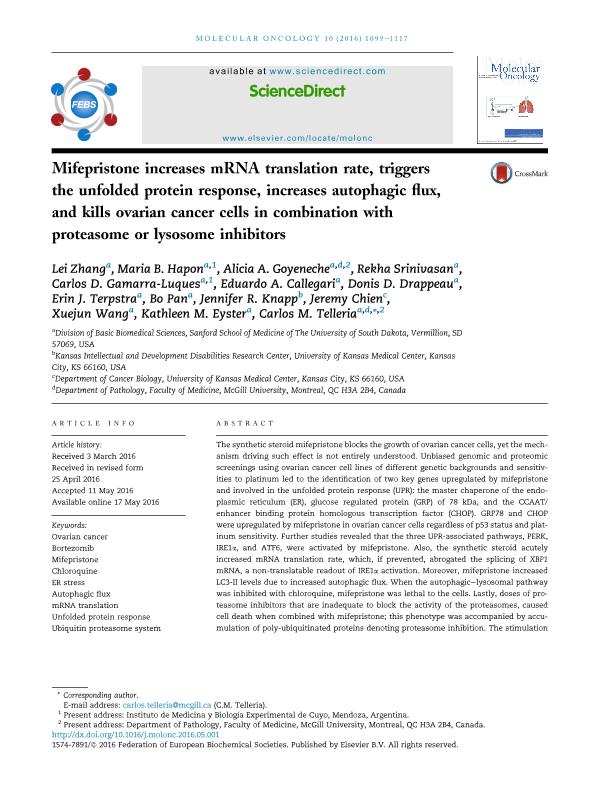Mostrar el registro sencillo del ítem
dc.contributor.author
Zhang, Lei
dc.contributor.author
Hapon, María Belén

dc.contributor.author
Goyeneche, Alicia A.
dc.contributor.author
Srinivasan, Rekha
dc.contributor.author
Gamarra Luques, Carlos Diego

dc.contributor.author
Callegari, Eduardo A.
dc.contributor.author
Drappeau, Donis D.
dc.contributor.author
Terpstra, Erin J.
dc.contributor.author
Pan, Bo
dc.contributor.author
Knapp, Jennifer R.
dc.contributor.author
Chien, Jeremy
dc.contributor.author
Wang, Xuejun
dc.contributor.author
Eyster, Kathleen M.
dc.contributor.author
Telleria, Carlos Marcelo

dc.date.available
2018-06-22T20:23:22Z
dc.date.issued
2016-08
dc.identifier.citation
Zhang, Lei; Hapon, María Belén; Goyeneche, Alicia A.; Srinivasan, Rekha; Gamarra Luques, Carlos Diego; et al.; Mifepristone increases mRNA translation rate, triggers the unfolded protein response, increases autophagic flux, and kills ovarian cancer cells in combination with proteasome or lysosome inhibitors; Elsevier; Molecular Oncology; 10; 7; 8-2016; 1099-1117
dc.identifier.issn
1574-7891
dc.identifier.uri
http://hdl.handle.net/11336/49777
dc.description.abstract
The synthetic steroid mifepristone blocks the growth of ovarian cancer cells, yet the mechanism driving such effect is not entirely understood. Unbiased genomic and proteomic screenings using ovarian cancer cell lines of different genetic backgrounds and sensitivities to platinum led to the identification of two key genes upregulated by mifepristone and involved in the unfolded protein response (UPR): the master chaperone of the endoplasmic reticulum (ER), glucose regulated protein (GRP) of 78 kDa, and the CCAAT/enhancer binding protein homologous transcription factor (CHOP). GRP78 and CHOP were upregulated by mifepristone in ovarian cancer cells regardless of p53 status and platinum sensitivity. Further studies revealed that the three UPR-associated pathways, PERK, IRE1α, and ATF6, were activated by mifepristone. Also, the synthetic steroid acutely increased mRNA translation rate, which, if prevented, abrogated the splicing of XBP1 mRNA, a non-translatable readout of IRE1α activation. Moreover, mifepristone increased LC3-II levels due to increased autophagic flux. When the autophagic–lysosomal pathway was inhibited with chloroquine, mifepristone was lethal to the cells. Lastly, doses of proteasome inhibitors that are inadequate to block the activity of the proteasomes, caused cell death when combined with mifepristone; this phenotype was accompanied by accumulation of poly-ubiquitinated proteins denoting proteasome inhibition. The stimulation by mifepristone of ER stress and autophagic flux offers a therapeutic opportunity for utilizing this compound to sensitize ovarian cancer cells to proteasome or lysosome inhibitors.
dc.format
application/pdf
dc.language.iso
eng
dc.publisher
Elsevier

dc.rights
info:eu-repo/semantics/openAccess
dc.rights.uri
https://creativecommons.org/licenses/by-nc-sa/2.5/ar/
dc.subject
Autophagic Flux
dc.subject
Bortezomib
dc.subject
Chloroquine
dc.subject
Er Stress
dc.subject
Mifepristone
dc.subject
Mrna Translation
dc.subject
Ovarian Cancer
dc.subject
Ubiquitin Proteasome System
dc.subject
Unfolded Protein Response
dc.subject.classification
Patología

dc.subject.classification
Medicina Básica

dc.subject.classification
CIENCIAS MÉDICAS Y DE LA SALUD

dc.title
Mifepristone increases mRNA translation rate, triggers the unfolded protein response, increases autophagic flux, and kills ovarian cancer cells in combination with proteasome or lysosome inhibitors
dc.type
info:eu-repo/semantics/article
dc.type
info:ar-repo/semantics/artículo
dc.type
info:eu-repo/semantics/publishedVersion
dc.date.updated
2018-06-18T19:09:38Z
dc.journal.volume
10
dc.journal.number
7
dc.journal.pagination
1099-1117
dc.journal.pais
Países Bajos

dc.journal.ciudad
Amsterdam
dc.description.fil
Fil: Zhang, Lei. University Of South Dakota; Estados Unidos
dc.description.fil
Fil: Hapon, María Belén. University Of South Dakota; Estados Unidos. Consejo Nacional de Investigaciones Científicas y Técnicas. Centro Científico Tecnológico Conicet - Mendoza. Instituto de Medicina y Biología Experimental de Cuyo; Argentina
dc.description.fil
Fil: Goyeneche, Alicia A.. University Of South Dakota; Estados Unidos. McGill University; Canadá
dc.description.fil
Fil: Srinivasan, Rekha. University Of South Dakota; Estados Unidos
dc.description.fil
Fil: Gamarra Luques, Carlos Diego. University Of South Dakota; Estados Unidos. Consejo Nacional de Investigaciones Científicas y Técnicas. Centro Científico Tecnológico Conicet - Mendoza. Instituto de Medicina y Biología Experimental de Cuyo; Argentina
dc.description.fil
Fil: Callegari, Eduardo A.. University Of South Dakota; Estados Unidos
dc.description.fil
Fil: Drappeau, Donis D.. University Of South Dakota; Estados Unidos
dc.description.fil
Fil: Terpstra, Erin J.. University Of South Dakota; Estados Unidos
dc.description.fil
Fil: Pan, Bo. University Of South Dakota; Estados Unidos
dc.description.fil
Fil: Knapp, Jennifer R.. University of Kansas; Estados Unidos
dc.description.fil
Fil: Chien, Jeremy. University of Kansas; Estados Unidos
dc.description.fil
Fil: Wang, Xuejun. University Of South Dakota; Estados Unidos
dc.description.fil
Fil: Eyster, Kathleen M.. University Of South Dakota; Estados Unidos
dc.description.fil
Fil: Telleria, Carlos Marcelo. University Of South Dakota; Estados Unidos. McGill University; Canadá. Consejo Nacional de Investigaciones Científicas y Técnicas; Argentina
dc.journal.title
Molecular Oncology

dc.relation.alternativeid
info:eu-repo/semantics/altIdentifier/doi/http://dx.doi.org/10.1016/j.molonc.2016.05.001
dc.relation.alternativeid
info:eu-repo/semantics/altIdentifier/url/https://febs.onlinelibrary.wiley.com/doi/abs/10.1016/j.molonc.2016.05.001
Archivos asociados
